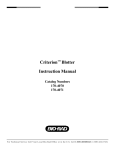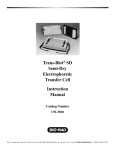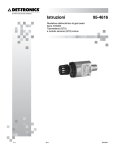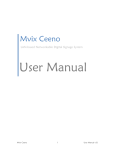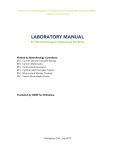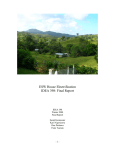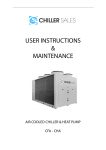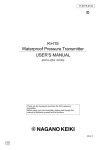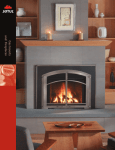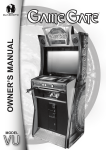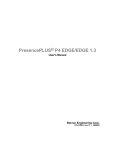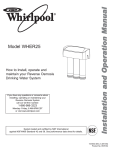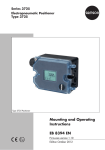Download - Bio-Rad
Transcript
Trans-Blot® Plus Electrophoretic Transfer Cell Instruction Manual Catalog Number 170-3990 For Technical Service Call Your Local Bio-Rad Office or in the U.S. Call 1-800-4BIORAD (1-800-424-6723) Table of Contents Page Section 1 General Information .........................................................................1 1.1 1.2 1.3 Introduction....................................................................................................1 Specifications ................................................................................................2 Safety.............................................................................................................3 Section 2 Set Up and Basic Operation of the Trans-Blot Plus Cell .............5 2.1 2.2 2.3 2.4 2.5 2.6 2.7 Components ..................................................................................................5 Additional Components .................................................................................6 Setting up the Tank and Cooling System .....................................................6 Assembling the Gel Sandwich and Cassette................................................8 Transfer .........................................................................................................9 Draining the Tank ........................................................................................10 Running Acidic Transfers ............................................................................10 Section 3 Transfer Conditions .......................................................................11 3.1 3.2 3.3 General Guidelines and Running Conditions .............................................11 Notes on Electrophoretic Transfer Conditions ............................................15 Buffer Formulations .....................................................................................17 Section 4 Strategies for Optimizing Electrophoretic Transfer ...................21 4.1 4.2 Optimizing Protein Transfer ........................................................................21 Optmizing DNA and RNA Transfer .............................................................23 Section 5 Choice of Blotting Membranes.....................................................23 5.1 5.2 Protein Blotting Membranes........................................................................23 DNA and RNA Blotting Membranes............................................................24 Section 6 Troubleshooting .............................................................................25 Section 7 Maintenance....................................................................................28 Section 8 Product Information .......................................................................29 Section 9 References ......................................................................................30 Section 10 Warranty ..........................................................................................31 Copyright© (2002) Bio-Rad Laboratories, Inc. All rights reserved. Section 1 General Information 1.1 Introduction The Trans-Blot Plus cell is an electrophoretic transfer cell designed for use with large format gels, such as those used with the PROTEAN Plus Dodeca cell, and for high-throughput blotting applications with smaller format gels, such as those used with the Criterion Dodeca cell. The Trans-Blot Plus cell is supplied with three gel holder cassettes, each with an effective blotting area of 26.5 x 28 cm. A pair of plate electrodes- a platinum-coated titanium anode and a stainless steel cathodemay be positioned 4 cm, 7 cm, or 10 cm apart for electrophoretic transfers of one, two, and three gel-containing cassettes, respectively. This variable placement ensures a minimum distance between electrodes, which increases the field strength and efficiency of transfer. Cooling, which is achieved with the Super cooling coil and a refrigerated recirculating water bath, is required for high-intensity transfers and is recommended for longer, overnight transfers. The Trans-Blot Plus tank is designed to simultaneously accommodate the two plate electrode cards, three gel holder cassettes and the Super cooling coil. 1 1.2 Specifications Trans-Blot Plus cell tank Overall dimensions Material Buffer requirement Buffer capacity 39.4 cm x 17.27 cm x 30 cm Acrylic 12 liters 14 liters Electrodes Electrode plate dimension Electrode card dimension Material Support card Anode plate Cathode plate Distance anode to cathode 22.86 cm x 24.45 cm 36.2 cm x 28.26 cm Molded Polycarbonate Platinum coated titanium Stainless steel Adjustable to 4 cm, 7 cm or 10 cm Cassettes Cassette dimension Material Blotting area Gel capacity per cassette 28 x 30.7 cm Molded Polyphthalamide (PPA) 26.5 x 28 cm 1 PROTEAN Plus, PROTEAN II XL, or PROTEAN II xi gel; 4 Criterion gels or 9 ReadyGel gels Gel/cassette assembly tray Material Overall dimensions Molded PETG 42 x 42 x 6.3 cm 2 1.3 Safety ! Power to the Trans-Blot Plus cell is supplied by an external DC voltage power supply. This power supply must be ground isolated in such a way that the DC voltage output floats with respect to ground. All of Bio-Rad’s power supplies meet this important safety requirement. Regardless of which power supply is used, the maximum specified operating parameters for the cell are: ! 300 VDC Maximum voltage limit 300 Watts Maximum power limit 40°C Maximum ambient temperature limit Current to the cell, provided from the external power supply, enters the unit through the lid assembly, providing a safety interlock to the user. Current to the cell is broken when the lid is removed. Do not attempt to circumvent this safety interlock. Always turn the power supply off before removing the lid, or when working with the cell in any way. The Trans-Blot Plus is certified to meet EN61010-1* safety standard for safety of laboratory equipment. Certified products are safe to use when operated in accordance with the instruction manual. This safety certification does not extend to other equipment or accessories not EN61010-1 certified, even when connected to the Trans-Blot Plus. This instrument should not be modified or altered in any way. Alteration of this instrument will void the manufacturer’s warranty, void the EN61010-1 safety certification and create a potential safety hazard for the user. Bio-Rad is not responsible for any injury or damage caused by the use of this instrument for purposes other than for which it is intended or by modifications of the instrument not performed by Bio-Rad or an authorized agent. *EN61010-1 is an internationally accepted electrical safety standard for laboratory instruments. 3 Trans-Blot Plus Cell Assembly of Parts Lid Super Cooling Coil Cathode Plate (Black) Gel Holder Cassettes (3) Anode Plate (Red) Buffer Tank Tra ns -B lo tP lus Cel l Handles Drain Port Fig. 1. 4 Section 2 Set up and Basic operation 2.1 Components Buffer Tank and Lid The buffer tank and lid combine to fully enclose the inner chamber during electrophoresis. The lid cannot be removed without disrupting the electrical circuit. Handles on both sides of the tank facilitate transport. Guide marks on the front and back of the tank identify appropriate fill levels for transfer buffer. On the inside, the tank has 5 separate slots for variable placement of the electrode cards and gel holder cassettes and a designated space for the cooling coil. Multiple ports on the lid allow three different connection points for the cathode (black) electrode card. Gel Holder Cassettes Each gel holder cassette has an overall effective blotting area of 26.5 x 28 cm. The gel/membrane sandwich is placed into the cassette between two fiber pads, which are also included. The gel holder cassette design includes three separate clamps that ensure even pressure across the gel and membrane sandwich. A detachable hinge mechanism prevents gel sandwiches from slipping during assembly. Super Cooling Coil Coolant from a refrigerated circulator (see Additional Components) passes through the Super cooling coil to cool the transfer buffer during high intensity or prolonged runs. Electrode Cards The Trans-Blot Plus cell is supplied with a pair of plate electrodes- a platinum-coated titanium anode and a stainless steel cathode. Both electrode cards are removable. The anode plate (red) must be placed into the slot that is nearest the front face of the buffer tank. The placement of the cathode plate (black) is variable; the cathode plate may be positioned in either the third, fourth or fifth slot (4 cm, 7 cm, or 10 cm away from the anode) for electrophoretic transfers of one, two, and three gel-containing cassettes, respectively. The electrode cards are held in place in the tank with the nylon screws (provided). Roller The roller is used to ensure proper contact between gel and membrane and to remove trapped bubbles during sandwich assembly. Stir bar A 3" x ½" stir bar is included with the Trans-Blot Plus cell and should be used during every electrophoretic run to maintain uniform conductivity and temperature during transfer. Drain Port and Quick-Connect Fitting The drain port and quick-connect fitting on the side of the Trans-Blot Plus cell facilitate draining the buffer from the tank after transfer. Remove at least half of the transfer buffer volume prior to moving the tank. 5 2.2 Additional Components Magnetic stir plate A magnetic stir plate with a surface area that is sufficient to accommodate the Trans-Blot Plus cell is required for constant stirring of transfer buffer during electrophoresis. Recommended stir plates include the PC-610 from Corning, the Cimarec 3 from Thermolyne and the Vel A from Cole Parmer. Refrigerated circulator The Trans-Blot Plus cell requires a refrigerated circulator to work with the Super cooling coil for optimal results. The recommended minimum cooling capacity of the refrigerated circulator is 300W at 20°C and minimum pump flow rate is 4 L/min. Recommended chillers include the Model RTE-7 from Thermo NESLAB and the Model WKL 26 from Thermo Haake. Tubing Tubing with a 3/8 " internal diameter is required to connect both ends of the Super cooling coil to the refrigerated circulator and for draining the tank using the quick-release fitting and drain port. Gel/ Cassette Assembly Tray The optional gel/ cassette assembly tray is large enough to accommodate a gel holder cassette and the buffer required for sandwich assembly and may be purchased separately (see Product Information). 2.3 Setting up the tank and cooling system 1. Prepare the transfer buffer. See Section 3.3 for buffer formulations. Generally, 15 liters of transfer buffer will suffice for electrophoresis, gel equilibration, and sandwich assembly. 2. Position the anode (red) electrode card into the tank, in the slot that is nearest the front face of the tank (see Figures 1 and 2). This is the only position possible for the anode plate since it is the only position that will provide a connection between the plate electrode and the anode leads in the lid. Tighten the electrode card in place with the white nylon screw. 3. Position the cathode (black) electrode card into the third, fourth or fifth slot from the front (4 cm, 7 cm, or 10 cm away from the anode card), depending on whether you will be transferring one, two, or three gel-containing cassettes, respectively (see Figure 2). Tighten the electrode card in place with the white nylon screw. 6 Super Cooling Coil SLOT 5 4 Cathode Plate (Black) 3 Gel Holder Cassette (1) 2 Anode Plate (Red) 1 Cathode Plate (Black) Super Cooling Coil One Gel Holder Cassette Loaded Super Cooling Coil Cathode Plate (Black) Gel Holder Cassettes (2) Anode Plate (Red) MAX LEVEL MIN LEVEL Two Gel Holder Cassettes Loaded Trans-Blot Plus Cell 1 CASSETTE Super Cooling Coil Cathode Plate (Black) Gel Holder Cassettes (2) Anode Plate (Red) Gel Holder Cassettes (3) Anode Plate (Red) Three Gel Holder Cassettes Loaded Fig. 2. 4. If necessary, adjust the position of the cathode leads (black) on the lid so that they correspond to the position of the cathode electrode plate (black) within the tank. 5. Position the Trans-Blot Plus cell on a magnetic stir plate. 6. Add transfer buffer to the appropriate fill line. Choose the fill line that is appropriate for the number of gel holder cassettes that you are using. Note: In order to avoid overflow and electrical hazards, do not fill the tank beyond the indicated buffer level lines marked on the tank. 7. Place the stir bar in the tank. 8. Start cooling. Cooling is required for high intensity field conditions and is recommended for prolonged, unsupervised runs. Place the Super cooling coil into its designated slot at the rear face of the tank. Connect the Super cooling coil to the refrigerated circulator according to the manufacturer's instructions. Avoid restrictive fittings, internal diameter reductions and excessive extensions of tubing. Turn on power to the stir plate. Note: To test that the cooling system is functioning properly before the first transfer run is initiated, place the Trans-Blot Plus cell on the magnetic stirrer and pour in 11 L of buffer (or water). With no power applied to the tank, the buffer should cool by 5°C in approximately 20 min. 7 2.4 Assembling the Gel Sandwich and Cassette Assembly Each gel sandwich will contain the gel and membrane sandwiched between two pieces of blot absorbent filter paper. To prevent contamination, always wear gloves when handling the gels, membranes and filter paper to prevent contamination. An optional gel/ cassette assembly tray is available for the Trans-Blot Plus cell (see Product Information). This tray is large enough to accommodate the gel holder cassette during sandwich assembly. The lid of the tray can be used for soaking membranes. Fiber Pad Filter Paper Membrane Gel Filter Paper Gel Holder Cassette (Red Plate) Clamp Fiber Pad Hinge Gel Holder Cassette (Black Plate) Fig. 3. 1. For each gel, cut one piece of membrane and two pieces of filter paper to the dimensions of the gel. Pre-cut membranes and filter papers are available (see Product Information). 2. Equilibrate gels and membranes by soaking them in transfer buffer for 15 minutes. 3. Pour ~ 3 liters of transfer buffer into a tray for assembly of the cassettes. 4. Place the black cassette plate into the tray with the clamps in their fully extended position. 5. Place a fiber pad on the black cassette plate, making sure it is thoroughly wet. 6. Place a piece of filter paper on top of the fiber pad. Make sure there is enough buffer to thoroughly wet the filter paper. 7. Carefully place the equilibrated gel on top of the filter paper. 8 Note: Extra care is required when handling large gels, first align one side of the gel with the side of the filter paper and slowly lower the rest of the gel. 8. Carefully place the pre-soaked membrane on top of the gel. Make sure the membrane is properly positioned as it touches the gel. To avoid ghost prints or artifacts, do not move the membrane after it is positioned. Use the roller to remove any air bubbles and to ensure proper contact between the gel and membrane. 9. Wet a second piece of filter paper in transfer buffer and place it on top of the membrane. 10. Soak a fiber pad in transfer buffer and place it on top of the filter paper. 11. Place the hinge of the upper cassette plate (red) into the hinge mechanism of the lower plate, and lower the upper cassette plate on top of the gel sandwich. Make sure that the gel sandwich is aligned below the rim of the hinge so that the cassette will close properly. 12. Working with one side at a time, apply firm pressure to the area adjacent to a clamp and slide the clamp in. 13. Once the cassette is closed and locked, insert it into the tank with the hinge side up. Make sure the red cassette plate faces the red electrode plate (see Figure 4). MAX LEVEL MIN LEVEL Trans-Blot Plus Cell 1 CASSETTE 2 CASSETTES 3 CASSETTES Fig. 4. 2.5 Beginning Transfer 1. Once all the cassettes are in place, check that the buffer level is between the maximum and minimum levels indicated on the tank. 2. Turn on the stir plate and check that the stirring and cooling are working properly. 3. Place the lid on the tank. 9 Note: The color-coded cables on the lid MUST attach to the electrode cards of the same color. Reversing the orientation of the cables will cause irreversible damage to the plate electrodes. 4. Connect the Trans-Blot Plus cell to the power supply. Begin the run. See Section 3.1 for suggested run times with various buffers. 5. Upon completion of the run, remove the cassettes and disassemble the gel sandwich on a flat surface so that one locking clamp can be released at a time. 2.6 Draining the tank After transfer, remove at least half the buffer in the tank before moving the tank off of the magnetic stir plate for cleaning. To drain the tank, use the drain port fittings provided and an additional length of tubing (see Additional Components). First, be sure that the open end of the tubing is placed into a receptacle that is large enough to accommodate all the buffer. Then, insert the male quick-connect fitting onto the drain port on the side of the tank (see Figure 5). The tank will begin to drain as soon as the connection is made. Fig. 5. 2.7 Running Acidic Transfers When transferring under acidic conditions, switch the orientation of the gel and membrane or simply reverse the orientation of the cassette so that the red side faces the cathode electrode card (black). Do not reverse the electrode plates or plug the cables into the reverse poles. This will cause irreversible damage to the plate electrodes. 10 Section 3 Transfer Conditions 3.1 General Guidelines and Running Conditions The electric field strength (V/cm) is the driving force in electrophoretic transfer. Therefore, the most efficient transfers are obtained when the distance between the electrodes of a blotting cell is reduced. The Trans-Blot Plus cell offers three different electrode placements resulting in anode to cathode distances of 4, 7, and 10 cm for transfer of one, two, or three gel holder cassettes, respectively. In any of these configurations, transfers may be performed under either high intensity or standard field conditions. High intensity field transfers require less than 5 hours to complete. Standard field transfers require up to 16 hours to complete and are generally run overnight. In order to produce such rapid transfers, high intensity transfers require higher power input and consequently, produce more heat. Use of the Super cooling coil is required for high intensity transfers and is recommended for standard field conditions, where the run time is prolonged and usually unsupervised. The following are recommended running conditions for a variety of transfer buffers and electrode distances. Transfers may be performed under either constant voltage or constant current settings. Constant voltage settings provide constant field strength and tend to provide the most efficient transfer. Use of the Super cooling coil should prevent heating when transferring under constant voltage. Please note that the run times will need to be increased for gradient gels and may need to be decreased if your proteins have a low molecular weight and transfer quickly. Transfer conditions should be optimized for every individual application. 11 Table 3.1 SDS-PAGE Gels These conditions were determined empirically using 12.5% Tris-HCl Criterion gels and prestained SDS-PAGE molecular weight standards (Catalog # 161-0318). See Section 3.3 for buffer formulations. High Intensity Field Conditions (Cooling Required) PLATE ELECTRODE DISTANCE 4 cm 7 cm Buffer Power conditions Run Time Towbin 60V/2A* 90V/3A 45 min 15–30 min CAPS 41V/2A 60V/3A 15 min 15 min 66V/2A 100V/3A 30 min 15–30 min 25V/2A 35V/3A 15 min 15 min 40V/2A 55V/3A 30 min 15–30 min Carbonate Power conditions Run Time 10 cm Power conditions 100V/2A 45 min 120V/2.4A 15–30 min Run Time 100V/1.5A 60 min 130V/~2.3A 15–30 min 95V/2A 30 min 120V/2.5A 15–30 min 55V/2A 80V/3A 30 min 15–30 min Standard Field Conditions (Cooling Recommended) PLATE ELECTRODE DISTANCE 4 cm 7 cm 10 cm Buffer Power conditions Run Time Power conditions Run Time Power conditions Run Time Towbin 10V/0.3A 20V/ 0.7A 30V/ 1.1A 16 Hrs. 10V/0.2A 20V/0.4A 30V/0.7 A 16 Hrs. 10V/0.15A 20V/0.3A 30V/0.5 A 16 Hrs. CAPS 10V/ 0.35A 20V/0.8A 4 Hrs. 10V/0.2A 20V/0.55 A 30V/0.9A 4 Hrs. 10V/0.2A 20V/0.4A 30V/0.6A 4 Hrs. 10V/0.7A 4 Hrs 10V/0.4A 20V/1A 4 Hrs 10V/0.33A 20V/0.7A 30V/1A 4 Hrs Carbonate * When running under constant voltage, the PowerPac 200 power supply will automatically cross over to constant current if the power supply's current limit is reached. 12 Table 3.2 Native Gels These conditions were determined empirically using 12.5% Tris-HCl Criterion gels and native horse myoglobin samples. See Section 3.3 for buffer formulations. High Intensity Field Conditions (Cooling Required) PLATE ELECTRODE DISTANCE 4 cm Buffer Towbin (no methanol) Power conditions Run Time 50V/2A 80V/3A 45 min 15–30 min 7 cm Power conditions 10 cm Run Time 90V/2A 45 min 100V/2.2A 15–30 min Power conditions Run Time 100V/1.7A 60 min 130V/2.3A 15–30 min Standard Field Conditions (Cooling Recommended) PLATE ELECTRODE DISTANCE 4 cm Buffer Towbin (no methanol) 7 cm Power conditions Run Time Power conditions Run Time 10V/0.3A 20V/0.7A 30V/1.1A 16 Hrs. 10V/0.2A 20V/0.4A 30V/0.7A 16 Hrs. 13 10 cm Power Run conditions Time 10V/0.15A 20V/0.3A 30V/0.5A 16 Hrs. Table 3.3 Isoelectric Focusing, Native, Acid Urea Gels, Basic Proteins These conditions were determined empirically using 12.5% Tris-HCl Criterion gels and native horse myoglobin samples. Read about acidic transfers in Section 2.7 of this manual. High Intensity Field Conditions (Cooling Required) PLATE ELECTRODE DISTANCE 4 cm Buffer 0.7% Acetic acid , pH 2.8 7 cm Power conditions Run Time Power conditions Run Time 50V/2A 70V/3A 45 min 15–30 min 70V/2A 110V/3A 60 min 15–30 min 10 cm Power conditions Run Time 100V/1.9A 60 min 125V/2.4A 15–30 min Standard Field Conditions (Cooling Recommended) PLATE ELECTRODE DISTANCE 4 cm Buffer 0.7% Acetic acid , pH 2.8 7 cm 10 cm Power conditions Run Time Power conditions Run Time Power conditions Run Time 10V/0.4A 20V/0.8A 16 Hrs. 10V/0.25A 20V/0.55A 30V/0.8A 16 Hrs. 10V/0.15A 20V/0.35A 30V/0.55A 16 Hrs. 14 Table 3.4 DNA and RNA These conditions were determined empirically using 5% uniform TBE Criterion gels and the low range Fluorescein labeled DNA standards. See Section 3.3 for buffer formulations. High Intensity Field Conditions (Cooling Required) PLATE ELECTRODE DISTANCE 4 cm 7 cm 10 cm Buffer Power conditions Run Time Power conditions Run Time Power conditions Run Time 1X TBE 30V/2A 40V/3A 30 min 15–30 min 44V/2A 67V/3A 45 min 15–30 min 63V/2A 93V/3A 60 min 15–30 min 1X TAE 21V/2A 30V/3A 30 min 15–30 min 35V/2A 50V/3A 45 min 15–30 min 454V/2A 70V/3A 60 min 15–30 min Standard Field Conditions (Cooling Recommended) PLATE ELECTRODE DISTANCE 4 cm 7 cm 10 cm Buffer Power conditions Run Time Power conditions Run Time Power conditions Run Time 1X TBE 10V/0.6A 16 Hrs. 10V/0.35A 20V/0.85A 16 Hrs. 10V/0.25A 20V/0.55A 30V/0.9A 16 Hrs. 1X TAE 10V/0.8A 16 Hrs. 10V/0.5A 16 Hrs. 10V/0.35A 20V/0.8A 16 Hrs. 3.2 Advice for Electrophoretic Transfer 1. Equilibration of gels All electrophoresis gels should be equilibrated in transfer buffer prior to electrophoretic transfer to remove contaminating electrophoresis buffer salts. If salts are not removed, they will increase the conductivity of the transfer buffer and the amount of heat generated during the transfer. Also, gels will shrink or swell to various degrees in the transfer buffer depending on the acrylamide percentage and the buffer composition. Equilibration allows the gel to adjust to its final size prior to electrophoretic transfer. Equilibration is not necessary in situations where the same buffer is used for both electrophoresis and transfer (e.g., native gel transfers). 15 2. Current limits The PowerPac 200 Power Supply is capable of a 200 Volt output. Unless a current limit is set, uncontrolled conductivity changes may result in full power being delivered to the Trans-Blot Plus cell. The transfer buffer may heat up (further increasing conductivity), resulting in a potential safety hazard. Refer to the PowerPac 200 Power Supply Instruction Manual for setting current limits and run times. 3. Polarity of transfer Do not reverse the polarity of the plate electrodes. This will result in corrosion and rusting of the stainless steel cathode. If this should occur, the stainless steel should be cleaned with a mild, non-abrasive cleanser to remove the rust. 4. Dissipating Heat Electrophoretic transfer entails large power loads and consequently, heat generation. The use of the Super cooling coil and a refrigerated circulating bath is required for high intensity field transfers and is recommended for long, unsupervised runs. Pre-chilling the buffer or the use of ice blocks are common practices for heat dissipation in blotting, yet their application for the Trans-Blot Plus cell should be limited to only runs lasting less than 1 hr and requiring less than 150 Watts total power. Placing the Trans-Blot Plus cell in the cold room is not an adequate means of controlling transfer buffer temperature. The tank of the Trans-Blot Plus cell is an effective thermal insulator, thus it limits the efficient dissipation of heat. 6. Using a stir bar during transfer For all blotting applications, a stir bar must be placed inside the Trans-Blot Plus cell, so that the transfer buffer is stirred during the course of the experiment. This will help to maintain uniform conductivity and temperature during electrophoretic transfer. Failure to properly control transfer buffer temperature results in poor transfer of macromolecules and poses a potential safety hazard. 7. Transfer buffer pH Do not adjust the pH of transfer buffers unless this is specifically indicated. Adjusting the pH of transfer buffers, when not indicated, will result in increased buffer conductivity, manifested by higher initial current output and decreased resistance. 8. Transfer buffer recommendations Use only high quality, analytical grade methanol. Contaminated methanol can cause increased transfer buffer conductivity and poor transfer. Reusing the transfer buffer is not advised, since the buffer will likely lose its ability to maintain a stable pH during transfer. Diluting transfer buffers below their recommended levels is also not advised, since this will decrease their buffering capacity. 9. Voltage limits Do not increase the voltage settings beyond those indicated in Tables 3.1–3.4 for overnight operation. Buffer conductivity must be close to the current listed and a current limit should be set on the power supply. If overnight transfers at low voltages are ineffective, and higher voltages are necessary, then decrease the transfer time and use active cooling with the higher voltage settings. Failure to decrease transfer time and use cooling may result in a safety hazard. 16 10. These variables will change total resistance and current readings: • Alterations to the buffer make-up, (e.g., addition of SDS or changes in ion concentration due to the addition of acid or base to adjust the pH of the buffers) • Gel pH, ionic strength, and percentage of acrylamide, especially if the gel has not been fully equilibrated • Volume of buffer (current increases when volume increases) • Transfer temperature (current increases when temperature increases) • Time during the transfer at which reading was taken (current normally increases as the buffering capacity diminishes with progress of the run) 3.3 Buffer Formulations All recipes in this section make 1 liter of buffer. A total of 15 liters is sufficient for transfer and gel/cassette assembly for the Trans-Blot Plus cell. Scale up the following recipes appropriately. Note that some buffers can be made as concentrated stock solutions and diluted prior to use. Some buffers may also be purchased as pre-made concentrated stock solutions. Do not add acid or base to adjust the pH of the following buffers. Use only analytical grade methanol because metallic contaminants in low-grade methanol will plate onto the electrodes. Always add methanol or ethanol last to prevent precipitation. Note: Some pH meter electrodes will not provide correct measurements of the pH of Tris buffers. If the pH of the buffer is incorrect, check that the pH meter electrode is designed to work with Tris buffers. If the pH meter electrode functions properly for Tris buffers and the pH is below 8.0, remake the buffer. 1. Buffers for SDS-PAGE gels Towbin Buffer This is a general purpose transfer buffer that was first described by Towbin8. Towbin Buffer with 20 % Methanol 25 mM Tris, 192 mM glycine, 20% v/v methanol, pH 8.3 a) Using 10X Tris /glycine buffer (catalog #161-0734 for 1L bottles or catalog # 161-0757 for 5L cube) 100 ml of 10X Tris /glycine buffer 700 ml of deionized water (dd H2O) 200 ml of methanol b) Using dry reagents: 3.03 g Tris 14.4 g glycine 600 ml deionized water (dd H2O) 200 ml of methanol add dd H2O to 1 liter 17 Towbin Buffer with 10 % Methanol 25 mM Tris, 192 mM glycine, 10% v/v methanol, pH 8.3 a) Using 10X Tris /glycine buffer (catalog #161-0734 for 1L bottles or catalog # 161-0757 for 5L cube) 100 ml of 10X Tris /glycine buffer 800 ml of deionized water (dd H2O) 100 ml of methanol b) Using dry reagents: 3.03 g Tris 14.4 g glycine 600 ml deionized water (dd H2O) 100 ml of methanol add dd H2O to 1 liter Towbin Buffer with 15 % Ethanol 25 mM Tris, 192 mM glycine, 15% v/v ethanol, pH 8.3 a) Using 10X Tris/ glycine buffer (catalog #161-0734 for 1L bottles or catalog # 161-0757 for 5L cube) 100 ml of 10X Tris /glycine buffer 750 ml of deionized water (dd H2O) 150 ml of ethanol b) Using dry reagents: 3.03 g Tris 14.4 g glycine 600 ml deionized water (dd H2O) 150 ml of ethanol add dd H2O to 1 liter 18 CAPS Buffer CAPS-based transfer buffers (10 mM CAPS, 10% methanol, pH 11) may be preferable for transfers of high molecular weight proteins (e.g. >50 000 Da) and in cases where the glycine component of Towbin buffer may interfere with downstream protein sequencing applications. CAPS Buffer with 20% Methanol 10 mM CAPS (3-(cyclohexylamino)-1-propane sulfonic acid), 20% methanol, pH 11 a) Using dry reagents: 2.21 g CAPS 600 ml deionized water (dd H2O) Adjust to pH 11 with NaOH add dd H2O to 800 ml 200 ml methanol CAPS Buffer with 10% Methanol 10 mM CAPS (3-(cyclohexylamino)-1-propane sulfonic acid), 10% methanol, pH 11 a) Using dry reagents: 2.21 g CAPS 600 ml deionized water (dd H2O) Adjust to pH 11 with NaOH add dd H2O to 900 ml 100 ml methanol CAPS Buffer with 15% Ethanol 10 mM CAPS (3-(cyclohexylamino)-1-propane sulfonic acid), 15% ethanol, pH 11 a) Using dry reagents: 2.21 g CAPS 600 ml deionized water (dd H2O) Adjust to pH 11 with NaOH add dd H2O to 850 ml 150 ml ethanol 19 Dunn carbonate buffer In some cases, this buffer may produce higher efficiency transfers and improve the ability of antibodies to recognize and bind to proteins. 10 mM NaHCO3, 3 mM Na2CO3, 20% methanol, pH 9.9 a) Using dry reagents: 0.84 g NaHCO3 0.318 g Na2CO3 (anhydrous) 500 ml deionized water (dd H2O) 200 ml methanol add dd H2O to I liter 2. Buffers for native gels Towbin Buffer 25 mM Tris, 192 mM glycine, pH 8.3 a) Using 10X Tris /glycine buffer (catalog #161-0734 for 1L bottles or catalog # 161-0757 for 5L cube) 100 ml of 10X Tris /glycine buffer 900 ml of deionized water (dd H2O) b) Using dry reagents: 3.03 g Tris 14.4 g glycine 600 ml deionized water (dd H2O) add dd H2O to 1 liter 3. Buffers for nucleic acid transfers TBE (Tris-Borate EDTA) 89 mM Tris borate, 2 mM EDTA pH 8.3 a) Using 10X TBE buffer (catalog #161-0733 for 1L bottles or catalog # 161-0770 for 5L cube) 100 ml of 10X TBE buffer 900 ml of deionized water (dd H2O) b) Using dry reagents (10X stock) 108 g Tris base 55 g boric acid 40 ml 0.5 M EDTA, pH 8.0 Add 100 ml of the 10X stock to 900 ml deionized water (dd H2O) to make a 1X working solution. 20 TAE (Tris-Acetate EDTA) 40 mM Tris-Acetate 1 mM EDTA a) Using 50X TAE buffer (catalog #161-0743 for 1L bottles or catalog # 161-0773 for 5L cube) 20 ml of 50X TAE buffer 980 ml of deionized water (dd H2O b) Using dry reagents (50X stock) 242 g Tris base 57.1 ml glacial acetic acid 100 ml 0.5 M EDTA, pH 8.0 Add 20 ml 50X stock to 980 ml deionized water (dd H2O) to make a 1X working solution. Section 4 Strategies for Optimizing ElectrophoreticTransfer 4.1 Optimizing Protein Transfer Generally, quantitative elution of denatured high molecular weight proteins is difficult. The following tactics, alone or in combination, will increase transfer efficiency. 1. Improve gel- membrane contact. Failure of molecules to bind efficiently to the membrane, caused by poor gel-membrane contact, is often confused with inefficient elution of proteins from the gel. Poor contact is usually due to excess moisture in the gel-membrane interface. Use the roller to assure good contact between the gel and membrane. Proper selection of filter paper thickness will also help assure good compression. Equilibrate the gel and membrane in transfer buffer for at least 15 minutes prior to transfer to prevent shrinking of either component during transfer, and to eliminate reactants such as urea or SDS from the gel. 2. Increase transfer time. An initial control should be performed to determine the time required for complete transfer1,2. Times may vary from as little as 15–30 minutes to as long as overnight. Remember all overnight applications should be performed at 10–30 Volts to minimize heating problems. 3. Increase the power. Initial controls should be performed to evaluate the efficiency of increasing the V/cm as well as its effects on the temperature of transfer. The temperature increase may change buffer resistance and subsequent power delivered, as well as the state of protein denaturation, thus affecting transfer efficiency. 21 4. Vary buffer type and pH. a. Reduce the buffer strength. Dilution of transfer buffer results in lower current at any given voltage. This will allow the use of higher voltages without excessive heating. b. b. Maximize the charge-to-mass ratio. Alcohols present in SDS transfer buffer strip SDS from proteins. Basic proteins in Tris, glycine, and methanol buffer at pH 8.3 may assume a state near isoelectric neutrality and thus, may transfer poorly. Buffers with pH of 9.5 to 10.0 have shown much better elution and binding characteristics for basic proteins such as lysozyme and histones3. c. Different buffer types at similar V/cm may yield different efficiencies. Generally Tris buffers allow more efficient transfer than acetate or phosphate buffers. d. Addition of 0.1% SDS detergent to Tris, glycine, and methanol buffer has been reported to increase transfer efficiency2. SDS, however, increases relative current, power, and heating. Temperatures below 10°C may precipitate the SDS so the starting buffer temperature will be higher. SDS may also affect the antigenicity of some proteins. SDS will aid in eluting the proteins from the gel, but it may reduce the binding efficiency of those proteins to the membrane4. e. Alcohol in the transfer buffer has opposing effects on the efficacy of transfer. Alcohol in the transfer buffer removes SDS from protein-SDS complexes and increases the affinity between proteins and nitrocellulose membranes. Alcohol also causes a reduction in gel pore size, restricting transfer of some proteins. Alcohol may also cause some proteins to precipitate and transfer inefficiently. Proteins bind efficiently to PVDF membrane in the absence of alcohol. Therefore, elimination of alcohol from the transfer buffer and use of PVDF membrane for SDS-protein transfers may constitute a logical strategy for analysis of high molecular weight or difficult-to-transfer proteins5,6. Alcohol is not required in the transfer buffer when proteins are being transferred from gels not containing SDS. 5. Alter membrane type. As mentioned in 4e, PVDF membrane allows transfer in the absence of alcohol. PVDF can increase the binding of low molecular weight proteins that sometimes blow through nitrocellulose when transfers are long enough or intense enough to transfer high molecular weight proteins. Use Immun-Blot PVDF if the blot will be developed with immunochemicals. Use Sequi-Blot PVDF is the proteins will be sequenced or analyzed by mass spectrometry. 22 4.2 Optimizing DNA and RNA Transfer Altering the gel percentage can solve problems with elution of nucleic acids. It may be somewhat more difficult to quantitatively transfer large amounts of DNA used in genomic blots. The following tactics should be considered for optimizing elution in such transfers. 1. Alter the gel composition. a. Lower % total monomer or % crosslinker for polyacrylamide gels. b. Lower % agarose. This allows better elution of high molecular weight DNA. 2. Alter the DNA denaturants. It has been found that glyoxal denaturation allows more efficient elution of DNA than NaOH. Boiling polyacrylamide gels to denature DNA has also been found to give excellent results7. Base denaturation often causes polyacrylamide gels to weaken and stick to blotting membranes. Section 5 Choice of Blotting Membranes 5.1 Protein Blotting Membranes A variety of blotting membranes are available, each with particular advantages depending on the needs of the experiment. The physical properties and performance characteristics of a membrane should be evaluated in selecting the appropriate transfer conditions. Table 5.1 Guide to Protein Blotting Membranes Membrane Pore Size Binding Capacity (µg/cm2) Nitrocellulose 0.45 µm 0.2 µm 80–100 General purpose protein blotting membrane Supported Nitrocellulose 0.45 µm 0.2 µm 80–100 Pure nitrocellulose cast on an inert synthetic support; increased strength for easier handling and for reprobing. PVDF 0.2 µm 170–200 High mechanical strength and chemical stability, used for protein sequencing and western blotting; low background to signal ration, enhanced binding in the presence of SDS. Must be wet in alcohol before equilibration in buffer. Nylon 0.2 µm 170 Recommended for nucleic acids 23 Notes PVDF Membrane Bio-Rad offers PVDF (Polyvinylidene difluoride) membranes that are ideal for immunoassays of blotted proteins (Immun-Blot PVDF) or amino-terminal sequencing and amino acid analysis (Sequi-Blot PVDF). PVDF retains proteins under extreme conditions, such as exposure to organic solvents or acidic or basic conditions. Greater protein binding capacity allows for better retention of easily transferred proteins, while allowing more time or higher voltages to transfer difficult or larger proteins. Greater protein retention during sequencing manipulations enhances the likelihood of obtaining information from rare, low abundance proteins, by increased initial coupling and more consistent yields. In addition, PVDF membrane exhibits better binding efficiency of blotted material in the presence of SDS in the transfer buffer. PVDF must first be wetted in 100% methanol but can then be used in a transfer buffer that does not contain alcohol. Nitrocellulose Membrane Nitrocellulose membranes have been used extensively for protein binding and detection2,6,8-10. Nonspecific protein binding sites are easily and rapidly blocked on nitrocellulose, avoiding subsequent background problems. No pre-activation of the membrane is required. With nitrocellulose, low molecular weight proteins (especially those <20,000 Da) may be lost during post transfer washes, thus limiting detection sensitivity11. Smaller pore size nitrocellulose membrane (0.2 µm), has been shown to be effective in eliminating this loss12. Large proteins (those >100,000 Da) that are denatured by SDS may transfer poorly to nitrocellulose if alcohol is added to the transfer buffer. Alcohol in the transfer buffer increases binding of SDS-proteins to nitrocellulose, but decreases pore sizes in the gel. 5.2 DNA and RNA Blotting Membrane Zeta-Probe® Nylon Membrane Zeta-Probe membrane is an ideal alternative to nitrocellulose for the analysis of nucleic acids. The membranes bind nucleic acids in low ionic-strength buffers, making electrophoretic transfer of nucleic acids from agarose and acrylamide gels possible. Zeta-Probe membrane allows efficient binding of all sizes of single stranded DNA and RNA in the presence of low ionic strength buffers13. Unlike nitrocellulose, Zeta-Probe membranes can be hybridized as many as 20 consecutive times. 24 Section 6 Troubleshooting Guide Poor transfer of proteins 1. Transfer apparatus is assembled incorrectly and the proteins are moving in the wrong direction. • The gel/membrane sandwich may be assembled in the wrong order or the cassette may be inserted in the tank with the wrong orientation. Check the polarity of the connections to the power supply. 2. Detection system is not working or is not sensitive enough. • Include proper positive and negative control antigen lanes to test for kit sensitivity. Consult kit manual. • Stain the gel after transfer with a total protein stain, like Coomassie® Blue or SYPRO Ruby, to make sure that proteins have left the gel. 3. Transfer time is too short. • Increase the transfer time. 4. Power is too low. • Always check the current at the beginning of the run. The current may be too low for a particular voltage setting. If the buffer is prepared improperly, the conductivity may be too low, and not enough power will be delivered to the cell. See the power guidelines for specific applications in Section 3. • Prepare new buffer or increase the voltage. • Try the high intensity blotting option. 5. Charge-to-mass ratio is incorrect (native transfers). • Try a more basic or acidic transfer buffer to increase protein mobility. Proteins near their isoelectric point will transfer poorly. (Buffer pH should be 2 pH units higher or lower than the pI of the protein of interest for optimal transfer efficiency.) 6. Power supply circuit is inoperative, or an inappropriate power supply was used. • Check the fuse. Be sure the voltage and current output of the power supply match the needs of the blotting instrument. 7. Methanol in the transfer buffer is restricting elution. • Reduction of methanol results in increased transfer efficiency of proteins from the gel, but it also diminishes binding to nitrocellulose membranes. Protein is precipitating in the gel 1. Use SDS in the transfer buffer. SDS can increase transfer efficiency, but it can also reduce binding efficiency to nitrocellulose and affect reactivity of some proteins with antibodies. 2. Eliminate alcohol from the transfer buffer (see Section 4). 25 Swirls or missing bands; diffuse transfers 1. Poor contact between the membrane and the gel. Air bubbles or excess buffer remain between the blot and gel. • Use the roller carefully to roll over the membrane in both directions until air bubbles or excess buffer is removed from between gel and membrane, and complete contact is established. • Use thicker filter paper in the gel/membrane sandwich. • Replace the fiber pads. Pads will compress and degrade with time, and will not hold the membrane to the gel. 2. The membrane is not properly wet or has dried out. • White spots on nitrocellulose membrane indicate dry areas where protein will not bind. If wetting does not occur immediately by immersion of the sheet in transfer buffer, heat distilled water until just under the boiling point, and soak the membrane until completely wet. Equilibrate in transfer buffer until ready for use. • Because of the hydrophobic nature of PVDF, the membrane must be prewet in methanol prior to equilibration in aqueous transfer buffer. Follow the directions in the product insert. 3. The gel electrophoresis may be at fault. • Artifacts of electrophoresis may occur as a result of poor gel polymerization, inappropriate running conditions, contaminated buffers, sample overload, etc. Consult your electrophoresis manual for more details. Gel cassette pattern transferred to blot 1. Contaminated or thin fiber pads are used. • Replace the fiber pads, or thoroughly clean the contaminated pads. 2. The transfer buffer is contaminated. • Make fresh solutions. Poor binding to the membrane — Nitrocellulose 1. 20% methanol in the transfer buffer is generally optimal for protein binding. • Make sure the buffer contains the proper amount of methanol. 2. Proteins may be transferring through the nitrocellulose. • Use PVDF or 0.2µm nitrocellulose (smaller pore size). Decrease the voltage if using the high intensity option. • Place an additional piece of nitrocellulose membrane in the gel sandwich and analyze this added piece for evidence of proteins that may have transferred completely through the first piece. 3. Proteins <15,000 Da may show diminished binding to 0.45 µm nitrocellulose, or may be washed from the membrane during assays. • Use PVDF or nylon membrane, which have higher binding capacities. 26 • Use Tween-20 detergent in the wash and antibody incubation steps. Reduce or eliminate the more stringent washing conditions. 4. SDS in the transfer buffer will reduce binding efficiency of proteins. • Reduce or eliminate the SDS from the transfer buffer. 5. The membrane may not be completely wet. • White spots on the membrane indicate dry areas where protein will not bind. If wetting does not occur immediately by immersion of the sheet in transfer buffer, heat distilled water until just under the boiling point, and soak the membrane until it is completely wet. Equilibrate in transfer buffer until ready for use. Poor Binding to the Membrane — PVDF 1. The membrane may not be completely wet. • Because of the hydrophobic nature of PVDF, the membrane must be completely soaked in methanol prior to equilibration in aqueous transfer buffer. Follow the directions in the product insert. 2. The membrane may have been allowed to dry during handling. • 3. A completely wet membrane has a gray, translucent appearance. White spots will form on the surface of the membrane, indicating that it has been allowed to dry. Since proteins will not bind to the dry spots, rewet the membrane with methanol and re-equilibrate in transfer buffer. Proteins may be transferring through the membrane. • Decrease the voltage if transferring under high intensity conditions. • Place an additional piece of PVDF membrane in the gel sandwich and analyze this added piece for evidence of proteins that may have transferred completely through the first piece. 4. SDS in the transfer buffer will reduce binding efficiency of proteins. • Reduce or eliminate the SDS from the transfer buffer. Power conditions are too high • Always check the current at the beginning of the run. The current may be too high for a particular voltage setting. If the buffer is prepared improperly, the conductivity may be too high, resulting in excessive power delivered to the cell. See the power guidelines for specific applications in Section 3. Immune-Specific Detection Overall high background, low signal, or lack of development of positive control. • Consult instructions for immune detection kit or reagents. Total Protein Detection Consult stain or detection kit user manual. 27 Section 7 Maintenance Cleaning • After transfer, remove at least half the buffer remaining in the tank before attempting to lift or move the tank from the magnetic stir plate for cleaning. See Section 2.6 for instructions. • Use mild soap and warm water to clean the electrodes, cassettes and buffer tank. Take special care when cleaning the electrode cards or plate electrodes. Do not use abrasives or strong detergents. Avoid scratching or marring the platinum plate. The cathode plate (stainless steel) can be cleaned with a mild abrasive to remove salt that may be deposited during normal operation. • Rinse fiber pads thoroughly under hot water and then in distilled deionized water. Improper cleaning of the fiber pads may lead to the appearance of artifacts on subsequent blots. Chemical compatibility • The Trans-Blot Plus cell components are not compatible with chlorinated hydrocarbons (e.g., chloroform), aromatic hydrocarbons (e.g., toluene, benzene), or acetone. Use of organic solvents voids all warranties. 28 Section 8 Product Information Catalog Number Product description 170-3990 Trans-Blot Plus Cell with Plate Electrodes and Super Cooling Coil, includes 3 gel holder cassettes, cell with lid and power cables, 6 fiber pads, 1 pack blot absorbent paper (26.5 x 28 cm; pack of 30), roller and stir bar 165-5052 PowerPac 200 Power Supply, 110/120 V 165-5053 PowerPac 200 Power Supply, 220/240 V Trans-Blot Plus Cell Accessories 170-3994 Trans-Blot Plus Gel/Cassette Assembly Tray 170-3995 Fiber Pads, 27 x 28.5 cm, 2 170-3996 Blot Absorbent Paper, 26.5 x 28 cm, 60 sheets 162-0251 Nitrocellulose Membrane, 0.45um, 26.5 x 28cm, 10 sheets 162-0252 Nitrocellulose Membrane, 0.2um, 26.5 x 28cm, 10 sheets 162-0253 Supported Nitrocellulose Membrane, 0.2um, 26.5 x 28cm, 10 sheets 162-0254 Supported Nitrocellulose Membrane, 0.45um, 26.5 x 28cm, 10 sheets 162-0255 Immun-Blot PVDF membrane, 26.5 x 28 cm, 10 sheet 162-0256 Sequi-Blot PVDF membrane, 26.5 x 28 cm, 10 sheets 170-3997 Stir bar 170-3998 Trans-Blot Plus Roller, 6 inch wide 170-3999 Trans-Blot Plus Gel Holder Cassette, 1 170-4990 Trans-Blot Plus Super Cooling Coil 170-4991 Trans-Blot Plus Platinum Anode Plate Electrode 170-4992 Trans-Blot Plus Stainless Steel Cathode Plate Electrode 170-4995 Trans-Blot Plus Cell Buffer Tank 170-4996 Trans-Blot Plus Cell Lid with Cables 170-4997 Trans-Blot Plus Gel Holder Cassette Clamps, 3 29 Section 9 References 1. Burnette, W. N., Anal. Biochem., 112, 195 (1981) 2. Erickson, P. G., Minier, L. N. and Lasher, P. S., J. Immun. Meth., 51, 241 (1982) 3. Szewcyzyk, B. and Kozloff, L. M., Anal. Biochem., 150, 403 (1985) 4. Perides, G., Plagens, U. and Traub, P., Anal. Biochem., 152, 94 (1986) 5. Gershoni, J. M. and Palade, G. E., Anal. Biochem., 124, 396 (1982) 6. Gershoni, J. M. and Palade, G. E., Anal. Biochem., 131, 1 (1983) 7. Peudelhuber, T. L., Ball, D. J., Davis, A. H. and Garrard, W. J., Nuc. Acids Res., 10, 1311 (1982) 8. Towbin, H., Staehelin, T. and Gordon,J., Proc. Nat. Acad. Sci., 76, 4350 (1970) 9. Anderson, N. L., Nance, S. L., Pearson, T. W. and Anderson, N.G., Electrophoresis, 3, 135(1982) 10. Howe, J. G. and Hershey, J. W. B., J. Biol. Chem., 2566, 12836 (1981) 11. Lin, W. and Kasamatsu, H., Anal. Biochem., 128, 302 (1983) 12. Polvino, W. J., Saravis, C. A., Sampson, C. E. and Cook, R. B., Electrophoresis, 4, 368 (1983) 13. Bio-Rad Technical Bulletin 1110 “Zeta-Probe Blotting Membranes” (1982) Coomassie is a trademark of ICI. 30 Section 10 Warranty The Trans-Blot Plus cell electrophoretic transfer cell is warranted for one (1) year against defects in materials and workmanship. If any defects occur during this warranty period, Bio-Rad Laboratories will repair or replace the defective parts without charge. The following defects, however, are specifically excluded: 1. Defects caused by improper operation. 2. Repair or modification done by anyone other than Bio-Rad Laboratories or an authorized agent. 3. Use of spare parts supplied by anyone other than Bio-Rad Laboratories. 4. Damage caused by deliberate or accidental misuse. 5. Corrosion due to use of improper solvent or sample. 6. Use with chlorinated hydrocarbons (e.g., chloroform), aromatic hydrocarbons (e.g., toluene, benzene), or acetone. For any inquiry or request for repair service, contact Bio-Rad Laboratories after confirming the model and serial number of your instrument. Warranty Information Model: Serial Number: Date of Delivery: Warranty Period: * EN61010 is an internationally accepted electrical safety standard for laboratory instruments. * When running under constant voltage, the PowerPac 200 power supply may automatically cross over to constant current if the power supply’s current limit has been reached. 31 Bio-Rad Laboratories, Inc. Life Science Group Bulletin 0000 US/EG Web site www.bio-rad.com Bio-Rad Laboratories Main Office Also in: Australia Ph. 02 9914 2800, Fx. 02 9914 2889 Austria Belgium Ph. 09-385 55 11, Fx. 09-385 65 54 China Brazil Ph. 55 21 507 6191 Canada Czech Republic Ph. (420) 2-4141 0532 Fx. (420) 2-4143 1642 Denmark Finland France Ph. 089 318 84-177, 7 Fx. 089 318 84-123 Hong Kong Ph. 852-2789-3300, Fx. 852-2789-1257 India Israel Ph. 03 951 4127, Fx. 03 951 4129 Japan Ph. 03-5811-6270, Fx. 03-5811-6272 Korea Ph. 82-2-3473-4460, Fx. 82-2-3472-7003 Latin America Ph. 305-894-5950, Fx. 305-894-5960 Mexico Ph. 52 5 534 2552 to 54, Fx. 52 5 524 5971 The Netherlands Ph. 0318-540666, Fx. 0318-542216 New Zealand Ph. 64-9-4152280, Fx. 64-9-443 3097 Norway Ph. 47-23-38-41-30, Fx. 47-23-38-41-39 Poland Ph. (48) 22-8126 672, Fx. (48) 22-8126 682 Portugal Russia Ph. 7 095 721 1404, Fx. 7 095 721 1412 Singapore Ph. 65-2729877, Fx. 65-2734835 South Africa 00 27 11 4428508, Fx. 00 27 11 4428525 Spain Ph. 34 91 590 5200, Fx. 34 91 590 5211 Sweden Ph. 46 (0)8-55 51 27 00, Fx. 46 (0)8-55 51 27 80 Switzerland Ph. 061 717-9555, Fx. 061 717-9550 United Kingdom Ph. 0800-181134, Fx. 01442-259118 Rev A 00-000 0000 Sig 0402 4006224 Rev B



































